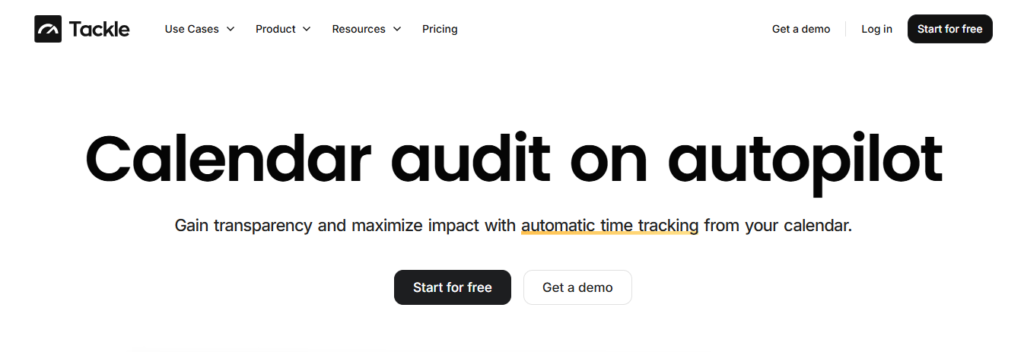Hiring the right team lead means identifying leadership habits, ensuring clear communication, delegating effectively, and making sound decisions under pressure. Even the best free habit tracker app can reveal a candidate’s consistency, follow-through, and how they prioritize work. What questions do you ask to test problem-solving, conflict resolution, coaching, and culture fit? This article provides a list of behavioral, situational, and technical team lead interview questions, along with interviewing tips for assessing candidates and providing performance feedback. It demonstrates how to gather evidence of real work habits.
Tackle’s automatic time tracking software reveals what candidates and teams actually do, enabling you to verify claims about priorities and consistency. Use it to back up your interview insights and make hiring choices based on actions, not just answers.
37 Team Lead Interview Questions to Ask Candidates

1. Motivation And Fit: Why Did You Apply For This Team Lead Position?
Ask the candidate this exact question to surface their drivers and alignment with your mission. Listen for evidence of research, specific reasons the role excites them, and whether they talk about team impact rather than title or pay.
Strong answers connect:
- Personal values
- Past experiences
- How they will contribute to your team’s objectives
Red flags include:
- Vague replies
- Focusing only on resume building
- No mention of the company’s or team’s needs
Follow-up: What would you change first if hired?
2. How They Lead Day To Day: Describe Your Leadership Style
Have the candidate define how they lead, in concrete terms, that you can observe.
Good answers name a style and give brief examples:
- Coaching
- Servant leadership
- Results-driven
- Situational
Probe for how they adapt their style for different people and problems, and how they balance direction with autonomy. Watch for inconsistency between claimed style and example behavior.
Follow up: Give a recent example where you adjusted your style and why.
3. What Keeps Them Engaged: What Motivates You as a Leader?
This question reveals the intrinsic and extrinsic motivators that influence decisions and persistence.
Look for focus on:
- Team growth
- Creating reliable processes
- Solving problems
- Building trust
Answers that focus solely on rewards or status may signal potential misalignment with team care and retention.
Ask: How do you sustain that motivation on repetitive or complex projects?
4. Their View of Team Health: What Do You Think Makes a Team Successful?
Listen for specific drivers like:
- Clear goals
- Trust
- Role clarity
- Communication
- Measurable metrics
- Accountability
Strong candidates link those drivers to daily practices, such as:
- One-on-one meetings
- Sprint planning
- Post-project reviews
Weak answers stay at a high level without showing how they create those conditions.
Follow-up: Which of those do you prioritize first and why?
5. Metrics And Reflection: How Do You Measure Your Own Success as a Leader?
Expect concrete metrics plus qualitative signals:
- Team retention
- Delivery accuracy
- Cycle time
- Employee engagement
- Upward feedback
Top candidates pair hard KPIs with soft measures, such as team morale and professional growth. Beware of leaders who only cite their personal promotion or praise from their manager.
Probe: What are the last three leader metrics you tracked, and what was their trend?
6. Evidence of Impact: What’s Your Proudest Professional Achievement as Part of a Team?
Ask for a specific example that shows leadership through collaboration and real results.
Good answers explain:
- The context
- Actions taken
- Measurable outcomes
- Lessons learned
Pay attention to ownership language and how they credit teammates. If the story lacks measurable results or reads like self-aggrandizement, dig deeper.
Follow-up: What would you do differently now?
7. Cultural and Strategic Fit: Why Do You Think You are the Right Fit for This Company?
This reveals whether they understand your:
- Values
- Product
- Market
- How they plan to add value to your business
Strong candidates reference the company goals, culture, and how their skills meet current gaps. Answers that sound templated or generic are a concern.
Ask: Which company value matters most to you, and show an example where you lived it.
8. Change Leadership: Describe a Time When You Led a Team Through a Difficult Transition
When circumstances require change, request a concrete example that demonstrates:
- Planning
- Communication
- Empathy
Listen for actions:
- Stakeholder mapping
- Phased rollout
- Training
- Feedback loops
Effective leaders demonstrate how they:
- Maintained morale
- Tracked adoption
- Adjusted their plans
Red flags include blaming others or failing to follow up on team sentiment.
Follow up: How did you measure adoption, and what happened next?
9. Accountability and Coaching: Tell Me About Managing a Poorly Performing Team Member
Look for a balanced approach:
- Diagnose skill gaps
- Set clear expectations
- Provide coaching
- Escalate when needed
Good answers show:
- Documentation
- A performance plan
- A humane end if no change occurred
Be wary of leaders who avoid confrontation or resort to punitive measures first.
Ask: Give an example of a coaching conversation you led and the outcome.
10. Ownership and Recovery: Give an Example of How You Handled Missing a Team Target
The candidate should describe:
- Root cause analysis
- Immediate corrective actions
- Preventative steps
Strong responses include:
- Transparent communication with stakeholders
- Revised timelines
- Lessons learned that are baked into the process
Watch for excuses or blame shifting.
Follow up: What process changes did you put in place to avoid recurrence?
11. Tough Conversations: Describe a Time When You Had to Deliver Negative Feedback to a Team Member
Expect a clear structure:
- Preparation
- Private setting
- Specific examples
- An impact statement
- A development plan
Top candidates show empathy and follow up to assess progress. Watch for lack of follow-up or vague feedback methods.
Ask: How did you measure the effectiveness of the feedback?
12. Rebuilding Morale: Tell Me About a Time You Motivated a Demoralized Team
Good answers include diagnostic steps such as:
- Listening sessions
- Short wins
- Role clarity
- Recognition systems
Candidates should explain how they measured and sustained improved morale and momentum. Weak stories focus on pep talks without structural fixes.
Follow up: What small win did you create first and why?
13. Delivery and Leadership in Practice: Give an Example of a Successful Project You Led. What Made it Successful?
Ask for:
- Context
- Goals
- Constraints
- Actions
- Measurable outcomes
Look for clarity in:
- Planning
- Risk management
- Cross-functional coordination
- Post-project review
Strong candidates identify specific leadership moves that made the difference, even if the success seems accidental or unsupported by data; probe further.
Follow up: What trade-offs did you accept and why?
14. Conflict Resolution: Describe a Situation Where You Resolved a Conflict Within Your Team
Listen for a methodical approach:
- Understanding both sides
- Separating people from problems
- Mediating
- Setting clear next steps
High performers show follow-up to restore trust and prevent repeat issues. Avoid candidates who minimize conflict or rely on top-down edicts.
Ask: How did you measure restoration of trust?
15. Decisiveness Under Pressure: Tell Me About a Time You Had to Make a Quick Decision With Limited Information
Good answers demonstrate a decision framework:
- Clarify acceptable risk
- Select a concise experiment
- Communicate the decision
- Iterate
Look for speed paired with accountability and rapid feedback. Red flags include paralysis or impulsive choices without review.
Follow-up: How did you validate the decision after the fact?
16. Practical Mediation Playbook: How Would You Handle Conflict Between Team Members?
Expect a step-by-step approach, including:
- Private conversations
- Facts over emotions
- Common goals
- Mediated agreements
- Follow-up checkpoints
Strong leaders establish clear behavior expectations and coach employees on conflict management skills. Beware of hands-off answers that let conflict fester.
Ask: How do you train the team to resolve conflicts proactively?
17. Recovery And Planning: What Steps Would You Take If Your Team Were Missing Deadlines?
Listen for:
- Immediate triage
- Root cause diagnosis
- Re-priorisation
- Stakeholder communication
- A revised plan with checkpoints
Candidates should identify tools or rituals to prevent repeats, such as capacity planning or scope control. Answers that focus only on pressure tactics or overtime are concerning.
Follow-up: How do you balance speed with quality in those moments?
18. Prioritisation Framework: How Do You Prioritise Multiple Urgent Tasks?
Top answers describe the criteria of business impact, risk, dependencies, and capacity, and then show how they communicate trade-offs. Look for use of backlog grooming, daily syncs, or RAG status to maintain alignment. Avoid vague statements like I just get things done without structure.
Ask: Provide a recent example where you prioritized and explain why.
19. Retention And Re-Engagement: What Would You Do If a Top Performer Suddenly Disengaged?
Expect a diagnostic conversation, a review of your workload and career path, and a tailored plan to help you reengage.
Effective leaders regularly check for signs of:
- Burnout
- Recognition gaps
- Misaligned incentives
Answers that assume the person will return on their own, thereby risking the loss of talent.
Follow-up: Describe one re-engagement tactic you used successfully.
20. Upward and Lateral Influence: How Would You Handle A Situation Where Your Team Disagreed With Management’s Decision?
Look for diplomacy:
- Gather team concerns
- Present data
- Seek clarification from management
Communicate the decision with rationale while advocating for the team. Effective leaders strike a balance between loyalty to leadership and precise representation of team needs. Avoid black and white stances that polarise.
Ask: How have you negotiated a change in management decision before?
21. Cost Control and Trade-Off Management: What Would You Do If a Project You Were Leading Was Going Over Budget?
Expect:
- Immediate financial triage
- Scope review
- Reforecasts
- Notification to stakeholders
Candidates should propose:
- Cost-reduction options
- Phased delivery
- Additional funding rationale tied to value
Red flags include ignoring the budget or blaming vendors only.
Follow up: How did you prioritize spending cuts without damaging outcomes?
22. Onboarding and Ramp Strategy: How Would You Bring a New, Inexperienced Hire Up to Speed Quickly?
Look for a structured ramp plan:
- Knowledge base
- Buddy system
- Focused milestones
- Frequent feedback
- Early wins to build confidence
Top leaders measure progress and adjust the plan to skills. Beware of one-size-fits-all onboarding.
Ask: What are the first three tasks you assign to new hires?
23. Strategic Alignment in Practice: How Do You Ensure Team Alignment With Company Objectives?
Seek answers that tie clear OKRs, regular check-ins, visible dashboards, and two-way communication into daily practice. Strong candidates demonstrate how they translate strategy into effective teamwork and measure their contributions. Weak answers fail to link team tasks to company goals.
Follow-up: How often do you revalidate team priorities in light of changes within the company?
24. Metrics and Operational Tools: What Tools or Methods Do You Use to Track Team Performance?
Candidates should name tools like:
- Project trackers
- Performance scorecards
- Time tracking
- Feedback platforms
They should explain how they utilize them, such as:
- Trend tracking
- One-on-ones
- Retrospectives
Look for balanced use of quantitative and qualitative data. Beware over-reliance on vanity metrics.
Ask: Which metric changed because of your actions and how?
25. Review Readiness and Coaching: How Do You Prepare Your Team For Performance Reviews?
Before review time, good answers describe:
- Continuous feedback
- Calibration sessions
- Evidence gathering
- Development plans are well
Leaders should involve team members in goal setting and documentation to ensure fair and proper reviews. Weak approaches leave feedback to the review meeting only.
Follow up: Give an example where pre-review coaching improved an outcome.
26. Operational Balance: How Do You Balance Day-To-Day Management Tasks With Long-Term Planning?
Listen for:
- Time blocking
- Delegation
- Regular strategic planning sessions
- Ensuring a small runway for innovation
Effective leaders delegate operational tasks and protect time for roadmap work and people development. Beware managers who are reactive and lack a growth plan.
Ask: What percentage of your time do you reserve for strategy, and why?
27. Fairness and Flow: What Strategies Do You Use to Manage Workload Distribution?
Look for load-balancing techniques:
- Capacity planning
- Leveling
- Cross-training
- Transparent allocation
Candidates should explain how they detect bottlenecks and reassign to prevent burnout. Answers that rely on heroics or constant overtime signal poor planning.
Follow-up: How do you handle spikes in demand?
28. Scheduling and Accountability: How Do You Track Project Milestones and Deadlines?
Expect use of:
- Milestones
- Clear owners
- Visual timelines
- Dependency maps
- Check-ins
Good leaders set early warning signals and change control practices. Avoid relying on vague emails or hope.
Ask: Provide an example of how milestone tracking saved a delivery and how you identified the issue.
29. Structured Ramp and Skill Build: Describe Your Approach to Onboarding and Training New Team Members
Candidates should describe:
- Phased training
- Curriculum
- Pairing
- Checklists
- Feedback loops
Practical approaches include measurable milestones and opportunities for early contributions. Beware ad hoc or hands-off onboarding.
Follow-up: How do you measure a successful ramp?
30. Growth and Career Pathing: How Do You Support Professional Development For Your Team?
Look for:
- Career conversations
- Training budgets
- Mentoring
- Stretch assignments
- Measurable skill plans
Leaders who track promotions and skill development show a culture of growth and development. Red flags include the absence of concrete plans or only generic training.
Ask: How do you connect development to business needs?
31. Skills Gap Closure: What’s Your Process For Identifying and Closing Skills Gaps?
To close gaps, strong candidates use:
- Performance reviews
- Skills matrix
- Regular assessments
- Personalized training paths
They tie gaps to hiring plans or internal training when feasible. Beware of ignoring systemic gaps or relying only on external hires.
Follow-up: Give a recent example where you closed a key skills gap.
32. Stakeholder Prioritisation: How Do You Handle Competing Priorities From Multiple Stakeholders?
This explores:
- Negotiation
- Impact-based prioritising
- Clear communication of trade-offs
Candidates should explain a process for scoring requests, aligning on objectives, and negotiating timelines. Leaders who fail to balance the needs of stakeholders create chaos.
Ask: Tell me about a time you re-aligned stakeholders and the result.
33. Smart Delegation: Describe How You Delegate Work and Ensure Accountability
Expect a framework. Choose tasks by:
- Development value
- Clarify outcomes
- Set checkpoints
- Empower ownership
Good leaders match task complexity to skill level and follow up without micromanaging. Poor delegation either hoards work or dumps tasks without context.
Follow-up: How do you recover when delegation fails?
34. Prioritisation and Resource Advocacy: How Do You Handle Under-Resourced Teams?
For more resources backed by impact data, look for:
- Triage
- Scope adjustment
- Cross-training
- Automation
- Active escalation
Strong leaders protect core delivery and find creative ways to achieve efficiency gains. Avoid answers that accept chronic under-resourcing as usual.
Ask: What trade-offs do you make first when resources drop?
35. Continuous Improvement: Tell Me About A Time You Implemented A Process Improvement
Good candidates:
- Describe the problem
- Small experiments
- Measurements
- Scale up when successful
They show stakeholder buy-in and a plan to monitor results. Weak answers describe change without metrics or follow-up.
Follow-up: What resistance did you face, and how did you overcome it?
36. Building Belonging: How Do You Foster Team Culture and Inclusion?
Expect actions:
- Inclusive hiring
- Shared norms
- Psychological safety practices
- Structured rituals
It gives voice to quieter members. Leaders should show examples of decisions that increased participation or reduced bias. Beware generic statements about being open.
Ask: What metric or signal do you use to track inclusion?
37. Signals That Matter: How Do You Measure Team Engagement and Retention?
Candidates should name pulse surveys, turnover rates, exit interview themes, one-on-one feedback trends, and manager scorecards as tools to track engagement. Strong leaders tie engagement signals to specific interventions and measure improvement over time.
Red flags include the absence of objective measurement or ignoring early warning signs.
Follow-up: Describe an intervention you ran because of an engagement signal and its effect.
Related Reading
- Happy Friday Meme
- How Many Work Weeks in a Year
- Friday Memes for Work
- Leadership Interview Questions
- How Many Weekend Days in a Year
- How Many Working Hours in a Month
Evaluating Answers: What to Look For

How to Judge Answers: Practical Criteria You Can Use
Look for concrete examples and measurable outcomes when assessing responses to team lead interview questions. Strong answers utilize the STAR method or a clear story arc that illustrates:
- The situation
- The candidate’s action
- The result or metric they achieved
Watch for specificity about team size, timelines, and trade-offs. Ask follow-up questions that press on the scope and impact to verify depth.
Empathy, Decisiveness, and Accountability: What Those Traits Sound Like in Practice
Empathy is evident in how a candidate describes handling people’s issues and supporting individual growth.
To accommodate different team members, they:
- Identified specific coaching moves
- Signals to watch for
- How they adjusted their communication
Decisiveness is evident when a candidate explains a time they chose a path despite:
- Uncertainty
- Weighed options
- Communicated the choice to stakeholders
Accountability is obvious when a candidate acknowledges mistakes, describes what they learned from them, and lists specific changes they made as a result. Which answer gives you a balance of human care and explicit action under pressure?
Communication Skills and Emotional Intelligence: How to Spot Real Strength
Listen for clarity, structure, and emotional awareness in stories about conflict or feedback. Candidates who use plain language, pause to acknowledge others, and explain how they rebuilt trust show high emotional intelligence.
Good interview answers include how they tailored messages to engineers, designers, or executives and how they checked for understanding. Ask for examples of delivering bad news or resolving cross-functional friction to see whether they stay calm and constructive.
Problem Solving and Adaptability: Evidence of a Solutions Mindset
Strong problem solvers break complex problems into testable steps and pick metrics to validate progress.
Candidates should describe:
- The alternatives considered
- The constraints they faced
- How they adapted as new information became available
Look for examples where they shifted priorities, reallocated resources, or changed a plan when results did not match expectations. Probe how they measure success and how they iterate when the first attempt fails.
Alignment With Company Culture and Values: How to Assess Fit Without Bias
Effective responses tie personal leadership habits to broader team goals, such as development, collaboration, or continuous improvement.
To reveal their alignment with your mission, ask candidates:
- How would they coach a low-performing employee
- Onboard a new hire
- Defend a vision to skeptical stakeholders
Evaluate whether their stated values match your norms on accountability, transparency, and professional growth. Use scenario questions that reflect your company’s priorities, allowing you to compare answers against a consistent set of criteria.
Practical Evaluation Tips and a Simple Rubric You Can Use
Score answers on clarity, evidence, leadership impact, and follow-up learning. Give weight to examples that include metrics, direct quotes, or documents such as plans or retrospectives.
Use behavioral and situational prompts, such as:
- Delegation
- Prioritization
- Handling missed deadlines
- Compare answers across candidates
Keep notes that map each response to competencies such as:
- Decision making
- Coaching
- Conflict resolution
- Stakeholder management
- Hiring judgment
From Manual Logs to Automatic Insights: How Calendar-Based Time Tracking Transforms Productivity
Tackle revolutionizes time tracking through seamless calendar integration, capturing and categorizing your time automatically with our advanced time tracking software.
Try it free with one click to see how it saves your team hours and provides clear insights into where your effort is going.
Related Reading
- How Many Saturdays Are in a Year
- Funny Timesheet Reminder Meme
- How to Make Time Go Faster at Work
- Submit Your Timesheet Meme
- Cute Friday Memes
- Recruitment Campaign
7 Tips for Conducting Effective Team Lead Interviews

1. See Thinking and Skills: Balance Open-Ended and Targeted Questions
Ask open-ended questions to let candidates reveal:
- How they think
- How they prioritize
- How they lead
For example, “Tell me about a time you led a project under pressure” shows process, judgment, and communication style. Pair that with targeted questions that probe specific competencies and tools, such as “What project management tools are you most comfortable with?” or “How do you track team velocity?”
Structuring Interviews for Depth and Breadth: Blending Leadership Narratives with Technical Signals
Balance the interview time to ensure you gather both narrative evidence of leadership skills and concrete signals of technical competency.
Without turning the conversation into a checklist, use:
- Behavioral interview and situational interview techniques to cover communication,
- Stakeholder management
- Problem-solving
- Technical fluency
2. Proof Over Promises: Ask for Specific, Real World Examples
Require candidates to give concrete, recent examples that show their role and impact.
Frame questions to elicit STAR-style responses:
- Situation
- Task
- Action
- Result
Try prompts like “Describe a time you had to mediate a conflict between team members. What did you do, and what was the outcome?”
Push for metrics and outcomes:
- How much did throughput change?
- How many people were coached?
- What happened to retention?
That separates theoretical leadership language from demonstrated performance. Listen for clarity about their role versus the team, and watch for evidence of repeatable practices in:
- Hiring
- Coaching
- Performance management
3. Test Reflection and Growth: Use Follow-Up Questions to Dig Deeper
After a candidate answers, follow up to test depth and learning. Ask “What would you do differently if you faced the same situation today?” or “How did that choice affect team morale or delivery?”
Follow-up questions reveal self-awareness, a commitment to continuous improvement, and the ability to adapt approaches based on feedback.
Probing for Consistency: Turning Claims Into Verifiable Evidence
Use probes to verify consistency:
- Cross-reference earlier answers
- Ask for examples of lessons applied later
- Request specifics about tools and timelines
That helps you assess coaching ability, decision-making, and whether they both accept and act on feedback.
4. Fit and Future: Assess Values and Growth Mindset
Go beyond technical knowledge to read values and mindset. Ask about coaching others, how they handle feedback, and their long-term goals. Questions like “How have you mentored a high performer to take on more responsibility?” or “Tell me about a time you received corrective feedback” show openness to growth and alignment with company culture.
Humility and Curiosity as Predictors of Coachability and Cultural Fit
Evaluate answers for humility, curiosity, and willingness to develop leadership skills.
This helps you weigh cultural fit alongside competency-based:
- Hiring metrics
- Avoiding confusion between confidence
- Coachability
5. Build Strong Teams: Evaluate Hiring, Training, and Team Development
- Experience in recruitment
- Onboarding
- Skills development
Ask “How do you approach training new team members?” and “What is your method for identifying skill gaps?” Expect structured processes, including clear hiring criteria, practical onboarding steps, regular one-on-one meetings, and measurable development plans.
Look for examples of:
- Setting clear expectations
- Conducting regular performance reviews
- Promoting from within
Good answers demonstrate a proactive approach to talent pipeline, competency-based interview design, and performance management that scales beyond a single contributor role.
6. Pressure Probing: Test Tenacity and Decision Making Under Pressure
Use situational questions to reveal resilience and judgment under stress. Ask “Tell me about a time your team missed a critical deadline. How did you handle it?” or “Describe when you had to make a quick decision with limited information.”
Listen for decision frameworks, emotional control, and ability to mobilize the team. Effective responses show calm prioritization, transparent communication with stakeholders, and a focus on recovery and learning.
Those answers reveal:
- How they perform in a crisis
- How do they balance risk versus speed
- How do they maintain steady team performance
7. Adaptation and Quick Thinking: Identify Creativity and Agility
Assess adaptability and creative problem-solving with scenarios that force trade-offs. Ask “Describe a situation where you had to change course quickly. What trade-offs did you make?” or “How have you redesigned a process to improve throughput or morale?”
Look for:
- Specific experiments
- Short feedback cycles
- Pragmatic use of limited resources
Good candidates can explain how they tested ideas, measured results, and iterated on them. That reveals their ability to lead through ambiguity, pivot across priorities, and coach others to think flexibly in the face of change.
Start Using Our Automatic Time Tracking Software for Free with One-click Today

Tackle removes manual time logging by reading your Google or Outlook calendar and capturing activities as they happen. The system classifies entries, fills gaps with intelligent browser-level capture, and assigns context, so you don’t spend hours reconstructing your day.
Trusted teams at Roblox, Deel, and Lightspeed Ventures rely on this flow to reduce bookkeeping and surface real work.
Tagging and Automation That Follow Your Process
Create custom tags that match projects, customers, or strategic initiatives and let the AI-powered rules apply them automatically.
Set simple heuristics for:
- Meetings
- Client calls
- Focus time
Let automations handle recurring classification. You can refine tags over time and use rules to split multi-purpose events into more accurate allocations, ensuring that reporting reflects reality.
Reporting Built Around the Questions Team Leads Face
Team leads preparing for interview questions about leadership, delegation, or performance management can pull metrics that directly answer those prompts.
Generate reports on:
- Meeting load
- Deep work hours
- Time spent coaching
- Cross-functional coordination
Use KPIs to show how you measure progress, illustrate prioritization choices, or quantify the effect of coaching on team throughput. Which metric would you present when asked how you drive team efficiency?
Turn Data Into Interview-Ready Stories
Use concrete numbers and the STAR method to respond to behavioral and situational questions. For a question about conflict resolution or delegation, export a timeline that shows who owned tasks and how time was allocated after a change.
For questions about decision-making or stakeholder management, attach meeting breakdowns and outcomes to demonstrate accountability and transparency. Recruiters and hiring managers value examples that include measurable impact and a traceable process.
How Executives, Team Leads, and Customer-Facing Pros Use Tackle
Executives monitor the time allocated to strategic initiatives to ensure headcount aligns with goals. Team leads track 1 one frequency and coaching time to shape development plans. Customer-facing professionals analyze the time spent on client calls versus preparation and follow-up to improve win rates.
Use Tackle to support performance reviews, hiring decisions, and roadmaps with data you can trust.
Set up, Privacy, and Integrations That Keep Things Simple
Connect Google or Outlook calendars in a few clicks and install the browser extension for intelligent capture. Access controls enable teams to share only the level of detail you want, and export CSV or dashboard views for stakeholders.
The platform centralizes time capture, tagging, and reporting, so you don’t have to stitch multiple tools together.
Interview Prep Exercises Using Tackle Data
Practice typical team lead interview questions by building a short packet for reviewers: a one-page dashboard with 3 KPIs, a week-by-week trend, and two annotated examples that show coaching or conflict outcomes.
Role-play questions about delegation, prioritization, communication, and stakeholder management using that packet as evidence.
Start Tracking in One-Click Free
Connect your calendar, create a handful of tags, set a couple of automations, and watch the platform assign time without manual entry. Try the free one-click setup and see how simple it becomes to turn calendar noise into interview-ready metrics.
Related Reading
- Unique Questions to Ask Leaders
- How Many Hours Do People Work in a Year
- How Many Days in the Year Without Weekends
- Benjamin Franklin Schedule
- Recruitment Campaign
- Payroll Reminder Meme
- Standard Work Hours in a Year


